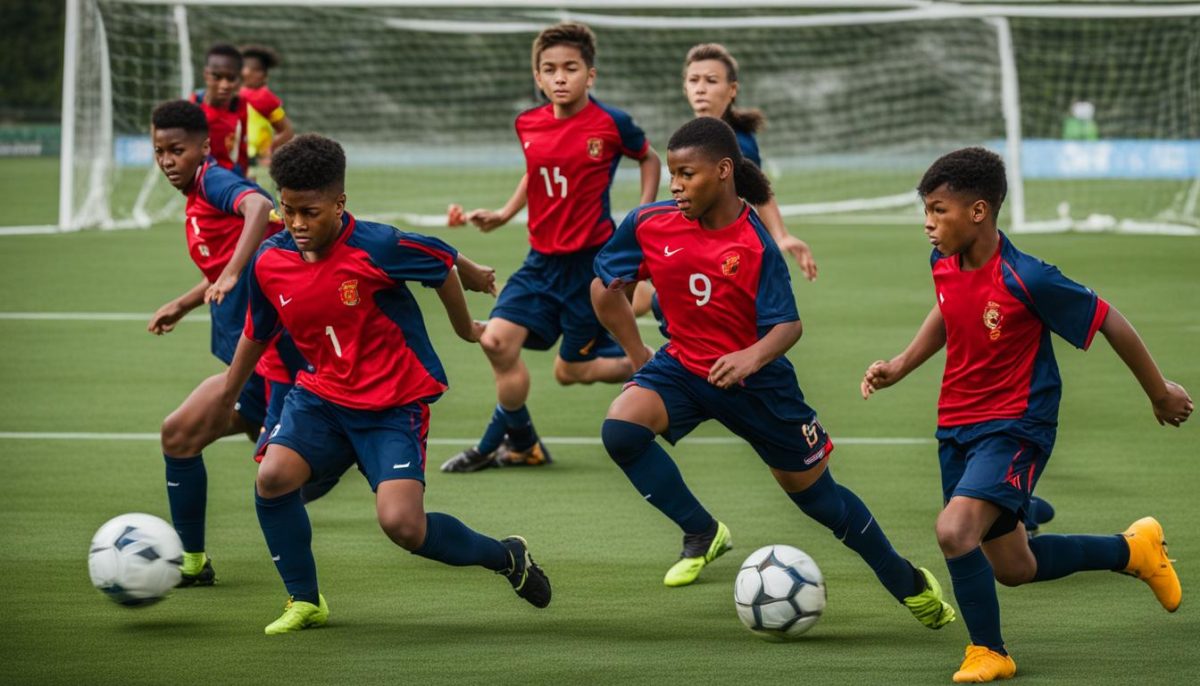Are You Wanting to Elevate Your Soccer Team to the Next Level and Dominate the Game? Discovering high pressing as an aggressive defensive strategy could give your team a distinct edge! High pressing provides a proven means for outplaying opponents while giving yourself and team an advantage during games.
What exactly is high pressing, and how can it fit into my game plan effectively?
With this comprehensive guide to high pressing, we will explore six effective strategies that will transform the performance of your team. Ranging from tactics and drills used by elite professionals all the way up to advanced strategies used by amateur players – we have it covered.
Consider how high pressing could make an impactful statement about how important possession is, constant pressure was applied and opportunities to convert turnovers were created? To get a clear picture, try this thought experiment: How would your team react if they could consistently dominate possession, apply relentless pressure, and create turnover opportunities?
Are you ready to elevate the success of your team’s soccer game? Join me as I show you some powerful techniques that can bring out its full potential.
Understanding Soccer Formations and Playing Systems
When it comes to implementing different tactics in soccer, understanding formations and playing systems is crucial. Formations refer to the organization of players on the field, while playing systems are the tactical strategies used during the game. By choosing the right formation and playing system, teams can effectively execute their game plan, including high pressing.
There is an assortment of formations to consider when creating a team formation; each formation offers its own advantages and drawbacks. Defensive formations like 5-4-1 or 4-5-1 focus on providing strong defensive foundation for high pressing strategies while balanced formations like 4-4-2 and 4-3-3 provide well-balanced approaches, prioritizing both defense and attack simultaneously. Attacking formations like 3-4-3 and 3-5-2 specialize in offensive prowess while maintaining pressure against opposing defense.
Each formation needs specific tactics and player roles in order to effectively apply high pressing. For instance, in a defensive formation players must remain organized and compact so as to restrict opponent space quickly when it becomes lost; balanced formation players should maintain an equal distribution between defensive duties and offensive contributions while keeping pressure high and disrupting opponent build-up play; finally in an attacking formation players need to emphasize width and depth, taking advantage of spaces left by opposition in order to open scoring opportunities through pressing.
Let’s take a closer look at three commonly used formations:
| Formation | Description | Tactics |
|---|---|---|
| 5-4-1 | A defensive formation that prioritizes a strong backline with limited attacking options. | – Tight man-to-man marking to deny space – Compactness to limit opponent’s chances – Quick counter-attacks with long balls |
| 4-4-2 | A balanced formation with four defenders, four midfielders, and two forwards. | – Pressing in midfield to disrupt opponent’s buildup – Wingers providing width and crosses into the box – Quick transitions from defense to attack |
| 3-4-3 | An attacking formation that emphasizes offensive firepower and increased goal-scoring opportunities. | – High pressing to force turnovers in the opponent’s half – Wingbacks providing width and overlapping runs – Fluid movement and rotation of front three for unpredictable attacking patterns |
Understanding the different formations and their associated tactics is essential for coaches and players looking to implement high pressing effectively. By analyzing the strengths and weaknesses of each formation, teams can adapt their playing systems to maximize their chances of success while maintaining a cohesive defensive and offensive strategy.
High Pressing Tactics for High Pressing Situations
High pressing is an aggressive defensive tactic which employs specific strategies to disrupt opponents’ build-up play and quickly recover possession. Teams may implement various plans depending on their formation for successful high pressing.
Defensive Formations:
One strategy used with high press is employing counterattacks against opponents’ aggressive positioning by quickly switching from defense to offense in rapid fashion – creating opportunities to score. By this strategy, opponents are caught off-guard while creating scoring opportunities within this new tactic.
Another effective tactic involves employing low pressing near their own penalty area to limit space for opposing teams. By creating an efficient defensive structure in this zone, teams can prevent opponents from penetrating into it easily and force hurried decisions resulting in errors on defense.
Compactness is central to high pressing. Players must keep close together while minimizing gaps between defensive lines; this ensures passing lanes are blocked off for opponents, decreasing options available to opponents while increasing chances of recovering possession back for your side.
Balanced Formations:
High pressing can often be coupled with possession and ball control strategies in balanced formations, enabling teams to dictate tempo of play while controlling possession while patiently waiting for opportunities to exploit opponents’ defensive vulnerabilities. This tactic enables team to dictate pace while controlling possession while waiting patiently to exploit vulnerabilities on opposing defense.
Fast transition play is another tactic commonly employed by balanced formations, emphasizing fast ball circulation so as to quickly transition between defense and attack, taking advantage of any disorganization from opponents in an opponent team’s defensive scheme.
Midfield pressing can also be advantageous in balanced formations, disrupting opponents’ rhythm and limiting their chance creation ability, which ultimately allows your team to regain possession and launch counter attacks of its own.
Attacking Formations:
Attacking formations combine high pressing with strategies designed to maximize every corner and depth of the field – keeping opponents under constant pressure by rapidly closing spaces quickly and restricting options available to them.
Player rotation and movement play an essential part in attacking formations. By switching positions frequently and making off-the-ball runs to disrupt opposition defenders and create spaces for their teammates to exploit, attackers can help confuse defenders while opening opportunities for teammates to exploit.
Teams employing attacking formations that prioritize width and depth to optimize high pressing rely heavily on width-depth pressure tactics; this strategy works to stretch their opponent’s defense, opening spaces for attack players to exploit and increasing scoring chances.
| Tactics Associated with High Pressing | Defensive Formations | Balanced Formations | Attacking Formations |
|---|---|---|---|
| Counter-attacks | Low pressing | Possession and ball control | Width and depth |
| Compactness | Fast transition play | Player rotation and movement | |
| Midfield pressing |
Adaptability and Tactical Flexibility (ATTF).
Adaptability and tactical flexibility are critical attributes in soccer success. To navigate its dynamic nature effectively, coaches and players alike must possess the agility to adapt formations, tactics, player roles based on each match’s particular circumstances.
Adaptability refers to teams’ abilities to adapt quickly and successfully in response to different playing styles used by their opponent. By studying and adapting their strengths and weaknesses, teams can design game approaches tailored specifically for them while neutralizing any tactics employed against them effectively.
Tactical flexibility requires being willing to adjust formations and tactics throughout a game, with coaches willing to alter formations depending on how a match unfolds or target an opponent’s weaknesses – whether that means transitioning from defensive formations into more offensive formations to apply pressure and create scoring chances or vice versa.
Another element of tactical flexibility is being able to change player roles during a match, whether through shifting positions or changing responsibilities on the field in response to specific situations or requirements of situations that arise during gameplay. This fluidity enables teams to maximize performance while adapting quickly to ever-evolving dynamics of games.
Dealing with different playing styles takes strategic planning and coordination between all members. Through effective communication on the field, teams can quickly adjust their tactics and formations in response to an opponent’s strategies; all members will remain on one page while transitioning smoothly from various tactical approaches.
“Adaptability and tactical versatility are vital ingredients of soccer success. To do this, our formations and tactics must adapt according to each match’s circumstances in order to neutralize an opponent’s playing style effectively,” according to Coach Alex Ferguson.
Overall, in today’s ever-evolving soccer environment, adaptability and tactical flexibility play an essential part in team success. Being able to change formations, tactics, player roles as well as deal effectively with various playing styles requires strategic planning, communication and coordination between teammates; by adopting these qualities teams increase their odds of victory while showing they excel under any situation.
Key Points:
- Adaptability and tactical flexibility are crucial for success in soccer.
- Teams must adapt formations, tactics, and player roles based on match circumstances.
- Responding to different playing styles requires strategic planning and coordination on the field.
- Changing formations and tactics throughout the game can neutralize the opponent’s strategies.
- Effective communication and coordination ensure seamless transitions between tactical approaches.

Offensive and Defensive Strategies
In addition to high pressing, coaches need to consider both offensive and defensive strategies. These strategies play a crucial role in a team’s overall performance and can greatly impact the outcome of a game. Let’s explore two key tactics: possession play and counter-attacking.
Possession Play
Possession play is a fundamental strategy in soccer that focuses on controlling the ball and maintaining possession for extended periods. Teams utilizing possession play aim to dominate the gam e by meticulously circulating the ball, patiently waiting for gaps in the opponent’s defense to exploit.
By successfully executing possession play, teams can dictate the tempo of the match, unsettle the opposition, and create scoring opportunities. This tactic requires exceptional technical skills, teamwork, and communication.
Counter-Attacking
Counter-attacking is a fast and decisive strategy employed by teams looking to exploit their opponent’s vulnerability during a transition from defense to offense. This tactic involves swiftly launching attacks and capitalizing on the spaces left behind by the opposing team’s forward movements.
Teams that excel in counter-attacking possess players with speed, agility, and exceptional decision-making abilities. By quickly transitioning from defense to offense, they catch the opposition off guard and create dangerous scoring chances.
Defensive Strategies
While offensive strategies are essential for scoring goals, defensive strategies play just as essential a role. Two commonly employed defensive techniques used by soccer clubs worldwide are man-to-man marking and zone defense – two strategies used by team captains when keeping possession.
Man-to-man marking entrusts each defender with the task of tracking and marking an opposing player throughout a match, with this tactic designed to prevent them from making attacks that penetrate defense lines. The goal is for every defender to closely mark and closely follow an opposing player throughout play to prevent time and space for attacks from being executed on them and penetrate defence.
Zone defense involves assigning individual defenders to specific areas of the field and holding each responsible for any player who enters that zone, encouraging teamwork, communication, and coordination among defenders to effectively cover every part of the pitch.
Man-to-man marking and zone defense require a comprehensive knowledge of defensive positioning, communication skills and being able to read the game.
Effective use of both offensive and defensive strategies such as possession play, counter-attacking, man-to-man marking and zone defense is crucial to team success. Coaches and players should assess their team’s strengths and weaknesses so that appropriate strategies may be employed during various game situations.
Set Pieces and Tactical Approaches
Set pieces, such as corner kicks, free kicks and penalty kicks provide teams with strategic opportunities to score goals and gain an advantage against their rivals. Coaches can employ various approaches and tactics in order to optimize these set pieces and increase chances of finding success with these set pieces.
Positioning players near the goalkeeper during corner kicks can be an effective tactic to create distractions for opposition defenders while providing opportunities for unmarked players to receive crosses or loose balls from corners. By drawing their attention away from this area, an offensive team creates space for runs by other players as they shoot at goal. By drawing away attention of opposing defenders towards this dense area near goal, an attacking team creates opportunities for unmarked players in advantageous positions to receive crosses or loose balls more freely from corners.
At free kicks, utilizing fake shots or passes as part of the strategy to confuse and create scoring chances is an invaluable strategy to dizzy an opposing team and increase scoring chances. By misleading defenders as to intended action, an attacking team gains the element of surprise that allows it to exploit any gaps or mispositioning from defensive walls or goalkeepers while creating scoring chances through deceptive movements or passing options; creating opportunities for shots on goal or well executed set piece routines.
Knowledge and practice of tactical approaches can give a team a distinct edge during set piece situations, providing teams with opportunities to increase offensive prowess and score goals and impact match outcomes positively.
Tactical Approaches for Set Pieces
| Set Piece Type | Tactical Approach |
|---|---|
| Corner Kick | Position players near the goalkeeper to create distractions and open up space for other attackers. |
| Free Kick | Incorporate fake shots or passes to confuse the opposition and create scoring opportunities. |
| Penalty Kick | Vary shot placement and use deceptive movements to outwit the goalkeeper and increase the chances of scoring. |
By employing these tactical approaches during set pieces, teams can optimize their scoring potential and gain an edge over their opponents.
Making Tactical Decisions: Substitutions and Formations
As coaches, making tactical decisions is an integral component of leading our teams towards victory. Two aspects that need careful attention when making tactical decisions as coaches include substitutions and formations. When planning substitutions strategically for our team’s needs and fitness levels of players we can inject fresh energy and skills into games more easily than otherwise.
Formations play a crucial role in our team’s tactics and gameplay, shaping both its tactics and gameplay. Tailoring our formations based on game circumstances enables us to emphasize specific strategies or exploit opponent weaknesses through adjustments of formations based on game situations. Therefore it’s critical that coaches understand both strengths and weaknesses associated with various formations to use them strategically for maximum advantage in our strategy game plans.
Assumptions must always be made when making substitutions and formation decisions; player fitness plays an extremely significant role. We must regularly evaluate our players’ physical condition in order to implement necessary adjustments that ensure peak performances while decreasing injury risks. Furthermore, man-to-man marking and zone defense tactics play an integral part in both substitutions and formation decisions as these strategies dictate who plays on which positions and against which opponents we allocate players on the pitch.
As coaches, ultimately it falls to us to make tactical decisions for our teams and achieve our desired goals. Every decision that we make, such as substitute selection or formation adjustments can have a direct effect on game outcome and could change its entire direction. By closely analyzing game situations and taking strategic steps accordingly we can lead our squads toward victory and reach their respective objectives.







